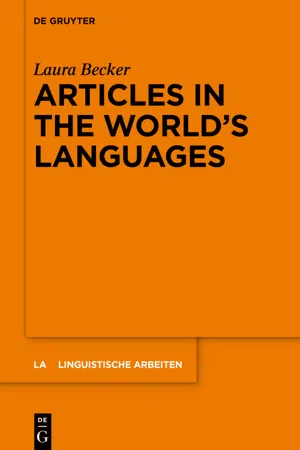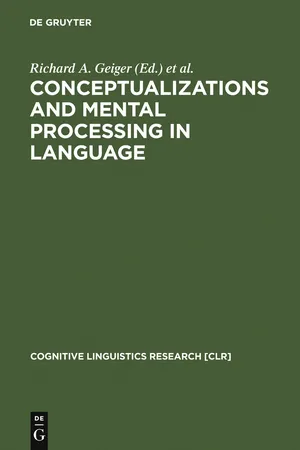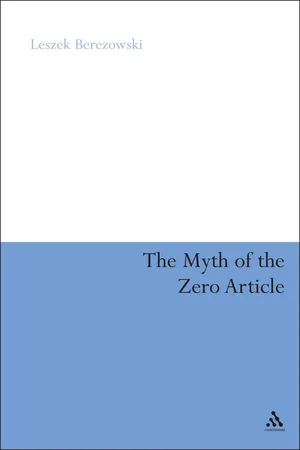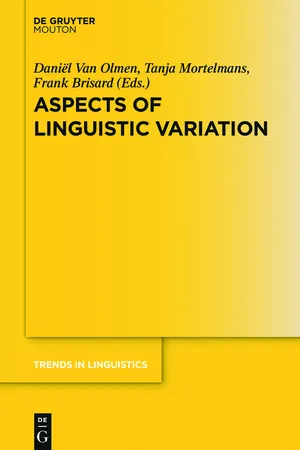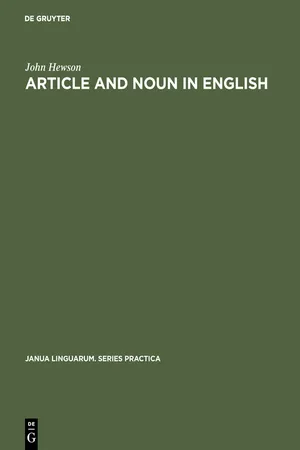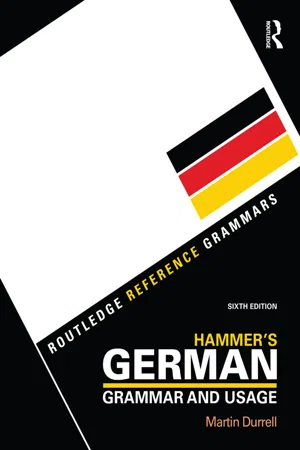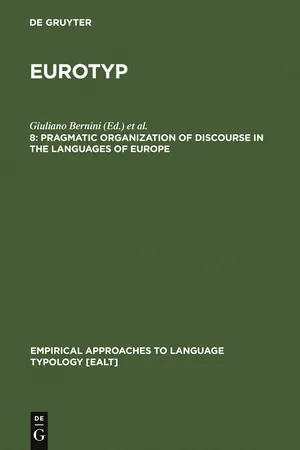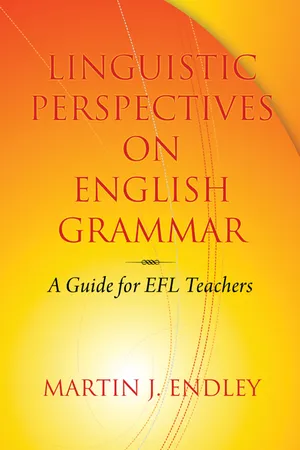Languages & Linguistics
Articles
In the context of languages and linguistics, "articles" are words that precede a noun to indicate the type of reference being made. In English, there are two types of articles: definite (the) and indefinite (a, an). Articles play a crucial role in specifying whether a noun is specific or nonspecific and are an essential part of grammar in many languages.
Written by Perlego with AI-assistance
10 Key excerpts on "Articles"
- eBook - PDF
- Laura Becker(Author)
- 2021(Publication Date)
- De Gruyter(Publisher)
Definite Articles will be defined as a morphological device (free morpheme, enclitic mor-pheme, or affix) with the primary function to denote the definiteness of noun phrases with anaphoric and/or nonanaphoric reference. […] “Indefinite article” will be defined as a morphological device (free morpheme, enclitic mor-pheme, or affix) with the primary function to denote the indefiniteness of noun phrases. (Schroeder 2006: 553, 555) The goal of this section is to define Articles as a crosslinguistic category based on criteria that can be applied to any marker in any given language, which allows us to discuss and compare Articles in the world’s languages. With this in place, I will further define 10 different types of Articles on the basis of their referential functions in Chapter 3. I propose three main criteria to define Articles as a crosslinguistic category. The first criterion is their function: Articles are defined as referential markers. The second criterion refers to their domain in that Articles have to occur together with lexical referential expressions. In most languages, such lexical, referential expres-sions will be nouns. However, nouns as a morphosyntactic category are not uni-versal and can therefore not be used as a comparative concept. The third criterion is concerned with the distribution of Articles and requires them to occur systemati-cally (allowing for exceptions) in the contexts matching their referential functions. The definition of Articles is given in (14). (14) Articles as a crosslinguistic category Articles are markers in the nominal domain whose main function it is to encode the referential function of the lexical referential expression that they occur with. 38 | 2 Articles as a crosslinguistic category In the following sections, I will discuss those three criteria in detail with examples from different languages. - eBook - PDF
- Geert E. Booij, Christian Lehmann, Joachim Mugdan, Geert E. Booij, Christian Lehmann, Joachim Mugdan(Authors)
- 2008(Publication Date)
- De Gruyter Mouton(Publisher)
Definite Articles, like per-sonal pronouns, are often derived from de-monstratives (Greenberg 1985). Not all lan-guages have definite Articles, and in lan- 792 X. Wortarten guages which do not, it is common for the demonstrative Articles to function as overt markers of definiteness in contexts where this is important, just as the demonstrative arti-cles are sometimes used in the absence of third person personal pronouns (other non-morphological means such as word order also compensate to indicate definiteness in a language without definite Articles). Indefinite Articles function to mark noun phrases which are ‘type identifiable’ in that the addressee must mentally access a repre-sentation of the type of object described by the expression (Gundel & Hedberg & Za-charski 1993: 276). They are thus similar to indefinite pronouns in that they are used to identify type rather than individual. Not all languages which have definite Articles also have indefinite Articles; rather, in some, the contrast is between a definite article and an unaccompanied noun; this is the case, for ex-ample, in Welsh dyn ‘man/a man’, y dyn ‘the man’ (King 1996: 15). Another variation on this is found in a language like German, where the indefinite article ein has a full case paradigm in the singular but lacks a plural. For much of the discussion below, it is conve-nient to combine definite and indefinite arti-cles in examining their morphology. Articles need not show morphological variation: in English, the definite article the and the indefinite article a/an show no varia-tion for either features of the head noun they are in construction with or for the grammati-cal relation of the nominal construction. Spanish Articles are inflected for the gender and number of their head nouns, as shown in Tab. 76.5. sg. pl. def.m. el los def.f. la las def.m. un unos indef.f. una unas Tab. 76.5: Spanish definite and indefinite Articles German Articles are inflected for number, gender and case. - Richard A. Geiger, Brygida Rudzka-Ostyn, Richard A. Geiger, Brygida Rudzka-Ostyn(Authors)
- 2011(Publication Date)
- De Gruyter Mouton(Publisher)
Articles in translation: An exercise in cognitive linguistics Elzbieta Tabakowska 1. Preliminaries Looking for equivalents of Articles in language that do not possess them as a separate grammatical category has long been considered a promis-ing task by linguists of varying orientations. For notoriously articleless languages like Polish, lists of proposed equivalents include such hetero-geneous entities as demonstrative and indefinite pronouns, lexical items defined as referring expressions, sentence stress, word order and, finally, context of situation, an often shapeless container used to dispose of all troublesome cases which resist attempts at rigorous classi-fication. Most textbooks as well as contrastive studies are based on the assumption that the system of Articles in languages like English is governed by grammatical rules which can be formulated and, conse-quently, memorized to good advantage by language learners, translators and everybody else. Inadequacy of the approach manifests itself in the inadequacy of the resulting performance. One of the recent publications which appeared on the Polish market, Douglas-Kozfowska's The Articles in Polish-English translation (1988), disappeared from the bookshops in a few days. The few who managed to get a copy must have been disappointed to find out that, like her pre-decessors, the author deals, albeit extensively, with several textbook categories only; she does not consider any of the problems of usage that torment learners and translators whose native language has no arti-cles. On the other hand, having assumed that Articles cannot be learned, native teachers of English assume that foreigners simply have to make errors and consistently correct Articles in their advanced learner's speech and writing in a way that leaves them even more baffled. What the teacher considers an error is frequently only an interpretational difference which merely reflects the possiblity of alternative views on reality.- eBook - PDF
- Leszek Berezowski(Author)
- 2009(Publication Date)
- Continuum(Publisher)
Article Grammaticalization 51 any way impair the efficiency or precision of communication. In fact the operation of the pragmatic machinery is so smooth and automatic that it is noticed at all and studied in any detail mostly only in research aimed at or induced by comparison with languages that have Articles. Grammars and papers written by linguists who do not have any comparative interests or back-ground in that type of research usually do not even mention the category of definiteness in discussing languages where it is not overtly marked. In doing so they tacitly assume that in the same fashion there are well-known cases of languages that do not have any overt markers of tense (Comrie 1987: 50–53), case (Blake 1994: 15–18), gender (Hellinger and Bußmann 2001: 16–17) or even number (Corbett 2000: 50–51), there are also languages with no overt markers of definiteness and that presumption is not unfounded. In fact it has been observed that the use of Articles actually is an aerial feature of a relatively limited number of languages tightly clustered in some regions of the world (Heine and Kuteva 2006: 99), e.g. Western Europe (Haspelmath 1998: 285), the Pacific (Lynch 2001) or the Mediterranean (Putzu and Ramat 2001). Highly restricted incidence of overt definite-ness and indefiniteness markers is also corroborated by statisti-cal calculations showing that at least one article is used only by around one-third of the languages of the world and two arti-cles are found merely in 8% of languages (Dryer 1989: 85–86). Given these facts it is evident that reliance on pragmatic infer-ence in conveying information on the definiteness and indefi-niteness of nominals is by far the most popular and unmarked case (Heine and Kuteva 2006: 98–99). - eBook - PDF
- Claudine Chamoreau, Isabelle Léglise, Claudine Chamoreau, Isabelle Léglise(Authors)
- 2012(Publication Date)
- De Gruyter Mouton(Publisher)
2. What is an article? 2.1. Definite Articles Following Himmelmann (2001), who in turn relies on Greenberg’s seminal work (1978), I take a fairly strict diachronic view of what a definite article is; it is only in this way that we can compare Basque and Romance definite Articles, since from a synchronic point of view one might think that they do not represent the same functional category. I illustrate this synchronic di¤erence in behavior with some examples below (see section 3.1.1). Briefly, a definite article can be defined as a grammatical category at a certain point on the diachronic continuum that leads from distal demon-stratives to definite Articles, 2 then to specific Articles, and finally to noun 2. This deliberately non-concrete synchronic definition of what we call ‘‘definite Articles’’ goes together with the wide range of di¤erent uses displayed by ele-ments of di¤erent languages that are assumed to be demonstratives and defi-nite Articles. The diachronic and language-specific view we are taking in this article will allow us to avoid these problems. 232 Julen Manterola markers, via grammaticalization, as in Himmelmann’s schema (2001: 832): ‘‘demonstrative ! definite article ! specific article ! noun marker’’. 3 As a general term for the grammaticalized elements that derive from a demonstrative, Himmelmann uses the term D-element. From a strict methodological point of view, calling a certain morpheme a definite article is thus simply a convention: we will not find a D-element in one language that behaves exactly the same way as in another. This is why it is so important to keep a diachronic perspective in mind when analyzing such morphemes, especially when, following Heine and Kuteva, I discuss con-tact-induced grammaticalization. There are at least two observations to be made about this deliberately simple definition. - eBook - ePub
- Daniël Olmen, Tanja Mortelmans, Frank Brisard(Authors)
- 2018(Publication Date)
- De Gruyter Mouton(Publisher)
Definite Articles have traditionally been identified and described for modern European languages (Germanic, Romance, Celtic, Basque, Hungarian, Bulgarian) and for Semitic languages. Moreover, emergent Articles can be found in the periphery of Europe, i.e., Finnish (Chesterman 1991), Sorbian and Polish (Heine and Kuteva 2006). In fact, definite Articles and their contrasts to indefinite ones are often considered to be one of the most characteristic features of Europe as a linguistic area (cf. Haspelmath 2001). The relevant grammatical category was absent, however, in earlier stages of Indo-European languages, with the exception of Classical, post-Homeric Greek. Typological studies have recently shown that something like definite Articles is also found elsewhere (in Central Africa, Meso-America and the Pacific).On the basis of his rich collections of data, Dryer (2005; 2014) has provided a comprehensive description of the diversity found in the forms and uses of definite Articles in the world. In one of his contributions to the World atlas of language structures , he identifies definite Articles cross-linguistically on the basis of the following syntactic criteria: they are free or bound morphemes, constituents of noun/determiner phrases, derived but different from adnominal demonstratives, typically forming an opposition with indefinite Articles, and they cannot occur on their own (i.e., they cannot be heads in the traditional sense of the term) (Dryer 2005: 154). These formal criteria are clearly applicable to the invariant pre-nominal article in English (the ), to the definite Articles in French, which inflect for gender (le , la ) and number (le , les ) and to the definite Articles in German, which inflect for gender (der , die , das ), number (die ) and case (der , des , dem , den and so on). They also apply to the post-posed Articles of Scandinavian (-en ), Bulgarian (-ta , -to , -te ), Romanian (-ul , -a and so on) and Basque (-a , -ak - eBook - PDF
- John Hewson(Author)
- 2017(Publication Date)
- De Gruyter Mouton(Publisher)
It does not follow that a language that has no article system therefore lacks empirical distinctions between these two functions or lacks the possibility of making such distinctions. From the universally binary nature of article systems (even if the binary contrast is between definite and zero as in Classical Greek) we may deduce that it is something inherent in the system of the noun in the Indo-European languages that the binary system of the article reflects. We have proposed that the relationship of the particular and general senses of the potential significate are expressed at the level of tongue in a binary system; this binary system expresses movement (from U 1 to S x and from S 2 to U 2 ), the movement of the acte de langage or constructive processes of language, movement that is the activity of tongue, the final result of which will be the arrival of the significant at the threshold of the conscious mind. The thought of the speaker, having already a basic notion in view, scans the varying values of the potential significate and chooses that one, particularizing or generalizing, objective or subjective in presentation, which provides him with the represen-tation he seeks. If there is no definer used and the language has an article system, the particular value of the representation will decide the use of the article: indefinite, definite or zero. If the language has no article system, the bare noun will be presented and the subjective presentations of the significate will often be indistinguishable from the objective ones. In a language that has no article system there is no distinguishing sign to mark the objective or sub-jective presentations. It would be reasonable to ask on what grounds we might suppose the existence of these two types of representation in languages where there is no definite sign of their existence. - eBook - PDF
- Martin Durrell(Author)
- 2016(Publication Date)
- Routledge(Publisher)
4 The Articles German, like English, has a DEFIN ITE and an IN DEFINITE ARTICLE . The Articles belong to a closed set of small words known as DETERMIN ERS . They are used with N OUNS to link them to a particular context or situation. Besides the Articles, the determiners include all those words, like the DEMON STRATIVES ( dieser , jener , etc.), the POSSESSIVE s ( mein , sein , etc.) and IN DEFINITES ( einige , etliche , etc.), which are used to specify nouns. They typically have first position in a N OUN PHRASE , before any adjectives, as shown in Table 4.1 . TABLE 4.1 The noun phrase: determiners (Articles) Determiner Adjective Noun der ein eine das runde schnelles außerordentlich langweilige in der bayrischen Hauptstadt gebraute Tisch Auto Zeitung Bier The form and use of the Articles are explained in this chapter; the other determiners are dealt with in Chapter 5 . The definite and indefinite Articles DECLIN E , i.e. they have endings which indicate the grammatical categories of the nouns they are used with: CASE , N UMBER and GEN DER . In practice the forms of the article are the main way these categories of the noun are shown in German, and mastering them is essential to be able to use and understand German. Tables 4.2 and 4.3 show the declension of the definite article der – die – das and the indefinite article ein – eine . TABLE 4.2 Declension of the definite article Masculine Feminine Neuter Plural Nominative Accusative Genitive Dative der den des dem die die der der das das des dem die die der den 76 The Articles TABLE 4.3 Declension of the indefinite article Masculine Feminine Neuter Nominative Accusative Genitive Dative ein einen eines einem eine eine einer einer ein ein eines einem In most instances (85%) German and English agree on whether the definite, indefinite or no (‘zero’) article is used with a noun in a particular context. - Giuliano Bernini, Marcia L. Schwartz, Giuliano Bernini, Marcia L. Schwartz(Authors)
- 2011(Publication Date)
- De Gruyter Mouton(Publisher)
But definite Articles not only indicate the identifiability of the referent of a noun phrase. In many languages that have definite Articles, either the Articles themselves or the distribution of their use also indicate where the referent is to be located. Some languages contrast their definite article with no article, for example, English, Bulgarian, and Rumanian. Here, the contrast between the use of the article and the non-use of the article merely indicates the contrast between one type of nonanaphoric reference, namely, proper names, and all other types of anaphoric and nonanaphoric reference. In these languages, sometimes also another type of nonanaphoric ref-erence, namely, unique reference, may be indicated by the non-use of the article, mostly in prepositional phrases and typically with nouns which refer to unique in-stitutions or natural phenomena (cf. Section 4.4.3). Also, a typical phenomenon in languages which have a demonstrative-derived definite article is the non-use of the article in frozen phrases, for example, binominals (e.g. face to face ), which are also nonanaphoric (cf. Himmelmann 1998 and the respective remarks in Note 11). The distribution of the two definite Articles in Jutish, Fering, and the Rhineland and Cologne dialects of Low German maintains a distinction between anaphoric and Articles and article systems in some areas of Europe 599 nonanaphoric reference. Remnants of this distinction can be found in Standard Ger-man and the Low German dialects of the North Sea coastal area, where the same opposition of two Articles only exists with nouns after prepositions; also, some rem-nants can be found in Danish and the Germanic languages of Scandinavia, though these languages primarily distribute their two definite Articles between different types of noun phrases and more or less follow the English, Bulgarian, and Rumanian pat-tern of article usage. A different case is the distribution of three definite Articles in Macedonian.- eBook - PDF
- Martin J. Endley(Author)
- 2007(Publication Date)
- Information Age Publishing(Publisher)
Consider (16): (16) a. a uniform, a university professor b. an hour, an X-ray The Articles in English: Meaning and Use While the form of the Articles is straightforward, real difficulties can arise for DUEs in terms of their meaning and use. I turn now to address some of these issues. When explaining the meaning and use of Articles, teachers often provide their students with neatly packaged rules. State- ments like the following are not uncommon: “Indefinite Articles are used for a noun when it is mentioned for the first time”; “Definite Articles are used for nouns that have already been mentioned.” “Rules” of this sort can be helpful up to a point. Sadly, they really don’t capture the way in which EUEs actually use Articles. To see why, and to see the kinds of difficulty that DUEs face in learning to interpret and use English Articles effectively, con- sider the passage below, which is taken from a recently published work of historical biography. You may be interested to know that this is the opening paragraph in the chapter. I have italicized the Articles. No one could quite agree how the Archbishop of Canterbury, George Ab- bot, came to kill Lord Zouch’s gamekeeper. Some said the arrow from the Archbishop’s careless crossbow deflected unluckily on a branch, striking Pe- ter Hawkins on the rebound. This became the favourite account: the tree was commemorated in local folklore for generations. But there was much debate about the missile’s trajectory. Abbot was visiting Zouch’s magnificent estate at Bramshill, near Reading, to consecrate the mansion’s newly completed cha- pel. It was a full summer day near the end of July, and the host invited his guest of honour to join a hunting party in the parklands. He may have had his TABLE 4.3 German Articles Singular Plural Masculine Feminine Neuter All genders Nominative der die das die Accusative den die das die Genitive des der des der Dative dem der dem den
Index pages curate the most relevant extracts from our library of academic textbooks. They’ve been created using an in-house natural language model (NLM), each adding context and meaning to key research topics.
